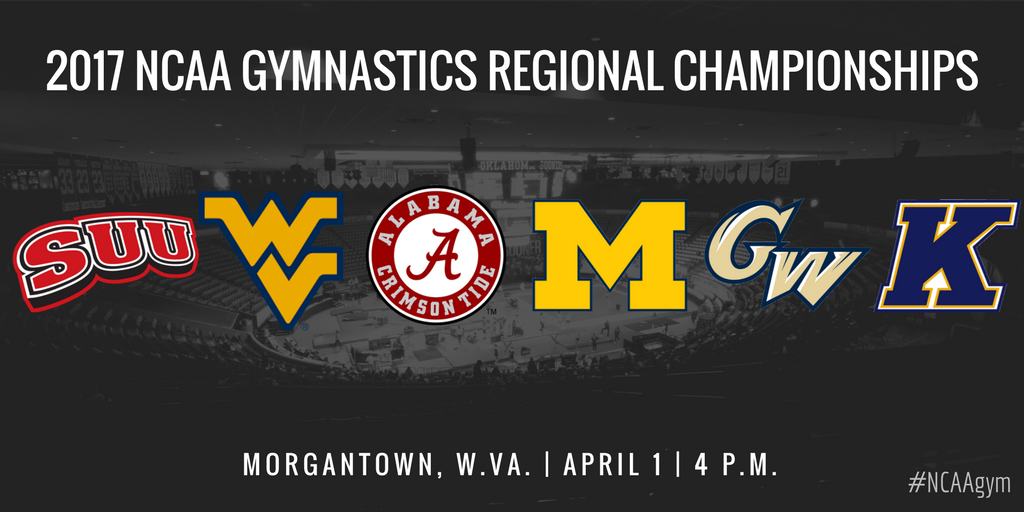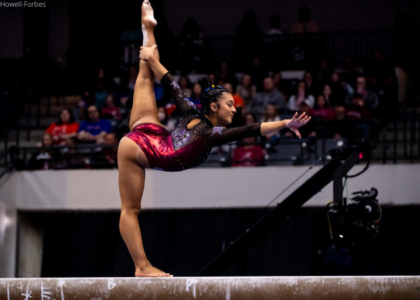By Elizabeth Grimsley
It’s finally that time of the year! We know where each of the top 36 teams in the country will travel to compete for a chance at advancing to nationals. In the days leading up to the championships, we’ll be previewing and analyzing each of the six regionals, discussing which teams have a chance of moving on and which individual could qualify as well. First up is the Morgantown regional, featuring No. 6 Alabama, No. 7 Michigan, No. 18 Southern Utah, No. 20 George Washington, No. 23 West Virginia and No. 31 Kent State.
Don’t forget to enter your postseason predictions in the 2017 NCAA Gym Bracket Challenge! The deadline for submissions is Friday, March 31 at 7 p.m. ET.
Team Qualifiers
|
Rank
|
Team
|
RQS
|
Average
|
High Score
|
Starting Event
|
|
No. 6
|
Alabama
|
197.355
|
196.963
|
197.825
|
Bars
|
|
No. 7
|
Michigan
|
197.135
|
196.823
|
197.825
|
Vault
|
|
No. 18
|
Southern Utah
|
196.380
|
195.957
|
197.025
|
Bye before Floor
|
|
No. 20
|
George Washington
|
196.340
|
195.975
|
196.725
|
Bye before Bars
|
|
No. 23
|
West Virginia
|
195.920
|
195.465
|
196.300
|
Beam
|
|
No. 31
|
Kent State
|
195.720
|
195.210
|
196.425
|
Floor
|
In probably the “easiest” regional for the top two seeded teams, Alabama and Michigan are the easy picks for advancing to nationals out of this regional. However, it won’t be a complete walk in the park like Oklahoma or LSU might have.
Both Alabama and Michigan have had some ups and downs this season. The Crimson Tide was upset by both Arkansas and Kentucky on the road, during the regular season but has since pulled it together, stringing together a series of meets in the mid- to high-197 range. While a third-place finish at the conference championship was probably disappointing to the team, especially after beating Florida earlier in the year, it’s still a good sign heading into regionals. Keely McNeer was back on beam after breaking her pinky in a car accident and missing the last couple of meets of the regular season, but had an uncharacteristic fall. Alabama will need her back at full strength on not just the event but her others as well—because while qualifying is the main goal, the scores each advancing team gets at regionals will help determine the rotation order for each semifinal at nationals. Michigan had similar issues during the season, performing exceptional at home but below average on the road. However, the Wolverines pulled it together to end the season, producing two road 197s at the Big 5 and Big 10 Championships. But Michigan has last season to think about, as it missed out on nationals after a strong season because of a beam disaster and the typical resurgence of Stanford.
Southern Utah has a long road to making nationals, but it’s a doable feat with a little help from its friends—er, fellow competing teams. The Thunderbirds started the season with some meets they’d rather forget (remember that beam rotation that included only two hit routines out of six?). But things have really turned around since then, with multiple program records surpassed over the weeks. While only matched at home so far, the team is capable of a 197 score as it proved this season. But with the competition away from Cedar City, Utah, a low- to mid-196 is more realistic. This means the team will have to rely on another Michigan beamplosion or Alabama upset if it wants to extend its season.
Then there’s the remaining three teams rounding out the regional. While George Washington technically isn’t a seeded team, the Colonials are essentially in the same position as Southern Utah and could easily finish third or even challenge for a nationals spot if the two top teams falter. However, the task won’t be as easy as it would have been if the Colonials had been placed in a different regional competition. West Virginia also can challenge for third with a good meet. The Mountaineers have a lower scoring potential of the previously named teams but are still capable of a low-196 team score. Finally, Kent State, as a team, will mainly be competing for the experience.
Individual Qualifiers
|
All Around
|
Vault
|
Bars
|
Beam
|
Floor
|
|
Majesta Valentine (WCU)
|
Tracey Pearson (Pitt)
|
Taylor Laymon (Pitt)
|
Brianna Comport (Bridgeport)
|
Brianna Comport (Bridgeport)
|
|
Lyanda Dudly (Cornell)
|
Kimberly Stewart (Bridgeport)
|
Daisy Todd (Temple)
|
Kaitlin Green (Cornell)
|
Maya Reimers (Bridgeport)
|
|
Caroline Morant (Brown)
|
Alt: Aya Mahgoub (Temple)
|
Alt: Kaitlin Green (Cornell)
|
Alt: Makenzie Shank (RU)
|
Alt: Tracey Pearson (Pitt)
|
|
Libby Groden (RU)
|
||||
|
Alt: Daisy Todd (Temple)
|
Gymnasts from the teams that do not qualify full squads have a chance of moving on as individuals. Assuming Alabama and Michigan advance as teams, that still leaves a number of great all around and event specialists with the potential to move on. While the top two all arounders not on a qualifying team will move on to NCAAs, there is no guarantee any event specialists will make it. George Washington’s Cami Drouin-Allaire and Jillian Winstanley each have a great opportunity of advancing to the next round. CDA made it to nationals in 2015 but just missed out last season. The Colonials duo are probably the best bet for the two all arounder spots.
However, they won’t be unchallenged. Southern Utah did not put up any four-event gymnasts at the most recent MRGC Championship but still has an opportunity to be represented at nationals. Stacie Webb scored a perfect 10 on beam at the last emet of the regular season and hit a 9.900 on both beam and floor at MRGCs. If Webb can put together a top performance—and it does have to be a top performance to qualify—she might just be booking her ticket to St. Louis. West Virginia could send a couple of event specialists as well. Kirah Koshinski is a vault sticking wiz, so if she can find her landing on her Yurchenko 1.5 at regionals, she might have a chance to advance. Koshinski is also strong on floor while Zaakira Muhammad is another possibility on the event.
As for Kent State, Rachel Stypinski probably has the best chance out of almost anyone in the country of qualifying as an individual on a specific event. Over the course of the 2017 season, she hit 9.925 or above five out of 10 on beam and six out of nine times on floor, including a 9.975 on the road. Her only real roadblock to another monster score on either event will be the name of the team on her leotard and the other strong gymnasts in the competition. Stypinski will have to match or better the likes of Nicole Artz, Talia Chiarelli, Kiana Winston, Nickie Guerrero and more on beam and/or floor if she wants to make it to nationals. Other remaining individuals hail from mostly teams in the ECAC, including Brown, Cornell, Temple and Bridgeport. Purple Knight Brianna Comport is strong on beam and floor, scoring multiple 9.900s on the event this season, and Brown’s Caroline Morant and West Chester’s Majesta Valentine are solid all arounders.





